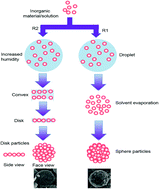Controlled fabrication of mesoporous TiO2 hierarchical structures as scattering layers to enhance the power conversion efficiency of dye-sensitized solar cells
Abstract
To meet the nanofabrication requirements, such as control of structure and scalability, we investigated an electrospray-based method to manufacture scattering layers (SLs) for dye-sensitized solar cells (DSSCs). TiO2 spherical and disk-shaped particles with a large surface area, high crystallinity, uniform nanostructure and good light scattering properties were fabricated via a simple electrospray method. We showed how the morphology and structure of the resulting films can be controlled by varying the droplet evaporation rates before impact on the substrate. Thus, by tuning the process conditions, high-quality TiO2 spheres and disks were obtained. Then, these mesoporous TiO2 particles were used as the SLs in photoelectrodes, which resulted in enhanced power conversion efficiency (PCE). Compared with conventional SLs (8.45%), DSSCs based on spherical and disk-shaped particle SLs yield higher PCEs of 9.0% and 9.53%, respectively. This is because the generated TiO2 spheres and disks provide a large surface area and exhibit excellent light scattering capabilities, allowing a low total internal resistance and a long electron lifetime.



 Please wait while we load your content...
Please wait while we load your content...